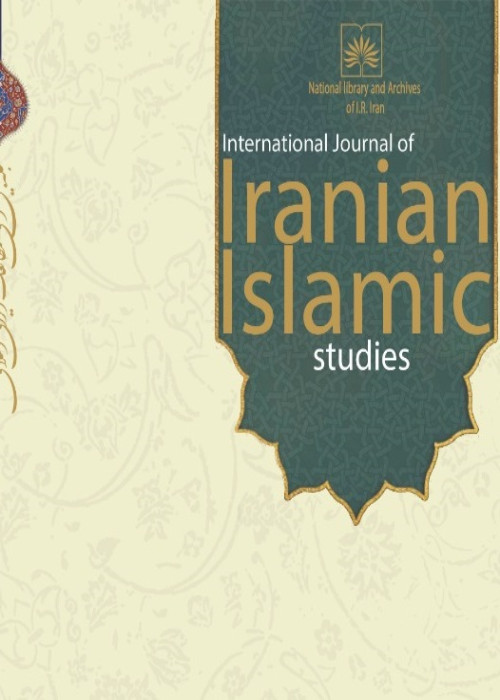Mohammad-Ali Jamalzadeh's approach to Iranian studies
Author(s):
Article Type:
Research/Original Article (بدون رتبه معتبر)
Abstract:
Mohammad-Ali Jamalzadeh was born in 1309 AH It is in Isfahan. During his 106 years of life, he has written many works such as books, articles, plays, translations, reviews and memoirs. In his works, the concern of knowing Iran and contributing to the progress and perfection of Iranian literature is evident. Jamalzadeh was a pioneer in contemporary literature and had an influence on many contemporary and later writers. In this article, an attempt has been made to examine the various aspects of the content of Jamalzadeh's works and to categorize and extract the position of Iranian studies in them. Also, the present research tries to rewrite the model of native Iranian studies in the content of Jamalzadeh's works. Also, this article intends to answer the question why Jamalzadeh's style is known as "literary democracy"? It seems that Jamalzadeh's folk literature contains a special attraction, and in addition to familiarizing the audience with contemporary language and literature, it is also used to convey the topics of Iranian studies or Iranian studies, especially historical geography and anthropology. Investigations showed that Jamalzadeh's special attitude towards various topics related to Iranian culture in the form of Iranian studies and including his works in various economic, cultural, social dimensions, customs and traditions, made him works the encyclopedia of Iranian studies. The research method in this review is the usual historical method based on description and analysis and using library sources. Introduction Mohammad Ali Jamalzadeh was born in Isfahan. His father Seyyed Jamaluddin Vaez Esfahani was one of the constitutional defenders. After finishing high school in Lebanon, Jamalzadeh first went to Switzerland and then to France and studied law. In 1293 AH / 1915 AD, at the same time as the First World War, he joined the Iranian Millions Committee (nationalists) in Germany and was sent to Baghdad and Kermanshah to carry out a mission. And with the continuation of the British conquests, he was forced to return to Berlin and cooperate with Kaveh newspaper. the payment. After Kaveh was closed and in 1302 AH. He was responsible for Iranian students at the Iranian Embassy in Berlin for 8 years and then went to Geneva, Switzerland. From the same year, Jamalzadeh taught Persian language and literature at the University of Geneva, and at the same time, he worked in the International Labor Organization and lived in Geneva until the end of his life. Therefore, this claim is true that the beginning of Jamalzadeh's social, political and cultural activities started in Berlin. He wrote the book Ganj Shaygan or the economic situation of Iran in 1297 AH more or less in simple language and participated in the Wednesday night meetings of the Million Committee (nationalists). With the encouragement of the people present in that gathering, especially Mohammad Qazvini, he entered the field of literature and story writing. After the closure of Kaveh due to financial problems, he took over the magazine "Science and Art" which was published in Berlin in the years 1307-1308 AH by the efforts of Abulqasem Wathouq.Iraj Afshar has categorized Jamalzadeh's works into several groups: A. Research writings B. Narrative C. Socio-political D: Translation.E: Tafanni's writings, F: Criticism and introduction of the book. In this article, we want to examine the topic of Iranian studies in Jamalzadeh's opinions and writings. Material & MethodsBy reviewing Jamalzadeh's works, he can be introduced as an encyclopedia of Iranian studies, because he paid attention to issues related to Iran and knowledge of Iran with a critical view, and his most important tool for knowledge of Iran is the use of simple, fluent, popular and understandable Persian literature, which can be considered as an introduction to 20th century Iranian studies. He used the most obvious tools or mechanisms in Iranian studies, which is the Persian language and literature, and invented an easy method for Iranian studies. He founded a literature that was understandable to both Iranians and non-Iranians. He considered literature to be the solution and gateway to the knowledge of Iran. Also, he paid attention to the eight classes of Iranian studies, which included culture, society, economy, politics, customs, art and architecture, urban planning, health and education, and he worked on them in a continuous and purposeful manner. Hence Jamalzadeh was considered the history, culture and geography of Iran itself. Since he observed the constitutional revolution in his youth, the First and Second World War in his middle age, the victory of the Islamic Revolution and the developments after the 1357 Iranian Revolution outside of Iran, he searched for the root of many events inside the country. Therefore, in this article, an attempt has been made to examine Jamalzadeh's works and introduce his Iranological indicators with the method of historical criticism Discussion of Results & Conclusions Studies have shown that Mohammad Ali Jamalzadeh is known as the father of modern Iranian story writing. Because by using common language and common people, he established a simple writing method. Ordinary and average people became interested in Jamalzadeh's works through simple and understandable writing and topics that existed in their daily life.Investigations showed that Jamalzadeh, who was a prolific writer in many fields of story writing, essays, translation, etc., tried to show the people, customs, culture, community, ethics, various economic and social corruptions, and the issues Let the people of Iran know the simple and then make them think. Investigations showed that Jamalzadeh even proposes a comprehensible and vernacular way of expression and the so-called localization for translation, which is a continuation of his special attitude towards the middle class and ordinary people. Of course, Jamalzadeh had an elite view of society, events and ethics. In addition to intelligently choosing the type of language for his audience, using language, the most basic and accessible tool of Iranian studies, he has expressed its examples in his numerous works.Investigations showed that Jamalzadeh, who was a prolific writer in many fields of story writing, essays, translation, etc., tried to show people customs, culture, community, ethics, various economic and social corruptions. and make them think.Investigations showed that Jamal Zadeh even suggests an understandable and native way of expression and the so-called localization for translation, which is in continuation of his special attitude towards the middle class and ordinary people.Of course, Jamalzadeh had an elite view of society. In addition to intelligently choosing the type of language for his audience, using language, the most basic and accessible tool of Iranian studies, he has expressed examples of it in his numerous works.
Keywords:
Language:
Persian
Published:
Journal of Iranian Islamic Studies, Volume:12 Issue: 2, 2022
Pages:
133 to 153
magiran.com/p2612561
دانلود و مطالعه متن این مقاله با یکی از روشهای زیر امکان پذیر است:
اشتراک شخصی
با عضویت و پرداخت آنلاین حق اشتراک یکساله به مبلغ 1,390,000ريال میتوانید 70 عنوان مطلب دانلود کنید!
اشتراک سازمانی
به کتابخانه دانشگاه یا محل کار خود پیشنهاد کنید تا اشتراک سازمانی این پایگاه را برای دسترسی نامحدود همه کاربران به متن مطالب تهیه نمایند!
توجه!
- حق عضویت دریافتی صرف حمایت از نشریات عضو و نگهداری، تکمیل و توسعه مگیران میشود.
- پرداخت حق اشتراک و دانلود مقالات اجازه بازنشر آن در سایر رسانههای چاپی و دیجیتال را به کاربر نمیدهد.
In order to view content subscription is required
Personal subscription
Subscribe magiran.com for 70 € euros via PayPal and download 70 articles during a year.
Organization subscription
Please contact us to subscribe your university or library for unlimited access!




